Report on Professional Practice and Development in Education
VerifiedAdded on 2021/02/21
|13
|4378
|88
Report
AI Summary
This report provides a comprehensive overview of professional practice and development in education and training. It examines the concept of professionalism, the influence of professional values, and the impact of social, political, and economic factors on education policy. The report also analyzes the roles of stakeholders and external bodies, the importance of accountability, and the impact of organizational requirements on curriculum practice. Furthermore, it explores quality improvement and assurance arrangements, the function of self-assessment, and identifies areas for improvement in learning programs. The report emphasizes the importance of continuous professional development and working in partnership with employers and stakeholders to ensure the quality and validity of education and training programs. Desklib offers additional resources and solved assignments for students seeking further assistance.

Professional Practice and
Development in Education
and Training
Development in Education
and Training
Paraphrase This Document
Need a fresh take? Get an instant paraphrase of this document with our AI Paraphraser
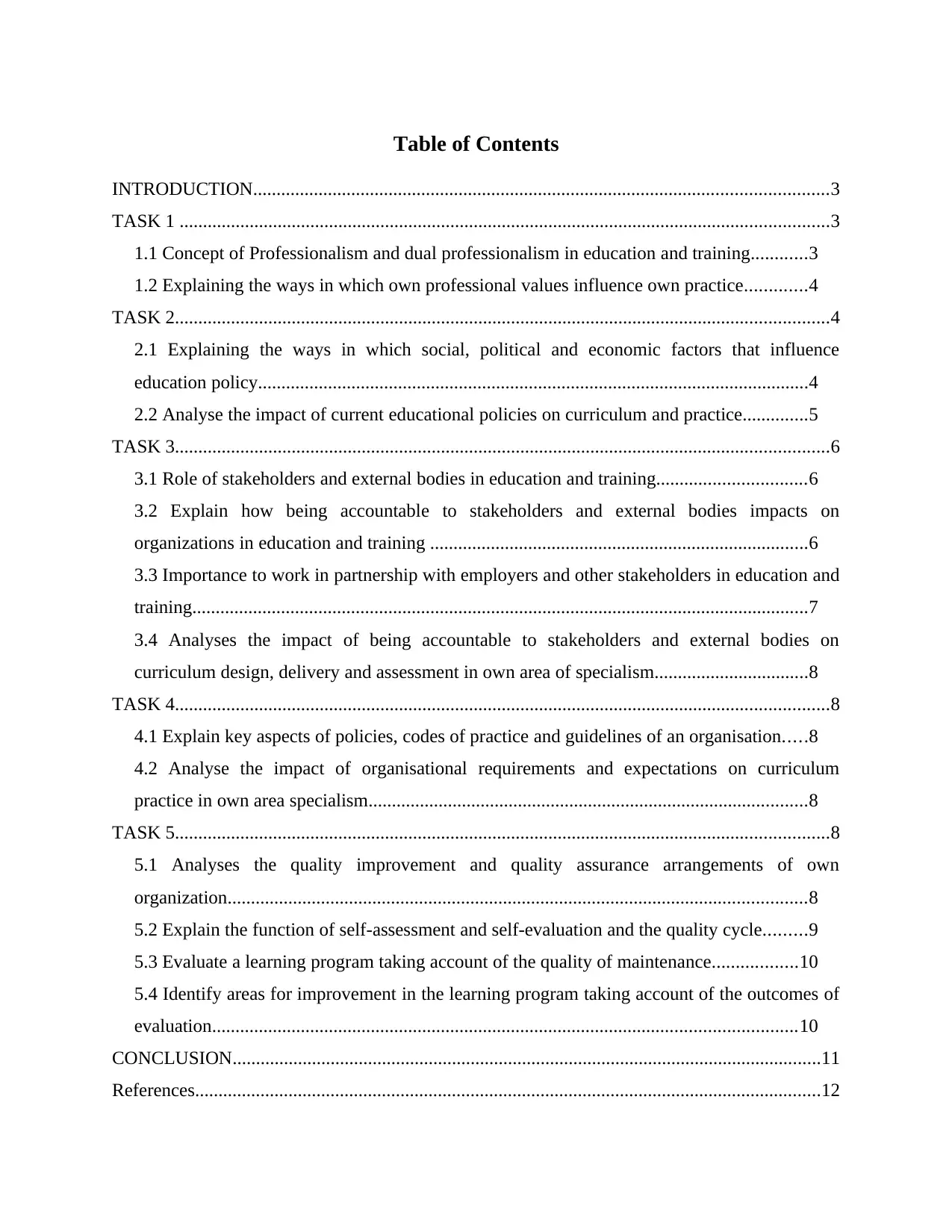
Table of Contents
INTRODUCTION...........................................................................................................................3
TASK 1 ...........................................................................................................................................3
1.1 Concept of Professionalism and dual professionalism in education and training............3
1.2 Explaining the ways in which own professional values influence own practice.............4
TASK 2............................................................................................................................................4
2.1 Explaining the ways in which social, political and economic factors that influence
education policy......................................................................................................................4
2.2 Analyse the impact of current educational policies on curriculum and practice..............5
TASK 3............................................................................................................................................6
3.1 Role of stakeholders and external bodies in education and training................................6
3.2 Explain how being accountable to stakeholders and external bodies impacts on
organizations in education and training .................................................................................6
3.3 Importance to work in partnership with employers and other stakeholders in education and
training....................................................................................................................................7
3.4 Analyses the impact of being accountable to stakeholders and external bodies on
curriculum design, delivery and assessment in own area of specialism.................................8
TASK 4............................................................................................................................................8
4.1 Explain key aspects of policies, codes of practice and guidelines of an organisation.....8
4.2 Analyse the impact of organisational requirements and expectations on curriculum
practice in own area specialism..............................................................................................8
TASK 5............................................................................................................................................8
5.1 Analyses the quality improvement and quality assurance arrangements of own
organization............................................................................................................................8
5.2 Explain the function of self-assessment and self-evaluation and the quality cycle.........9
5.3 Evaluate a learning program taking account of the quality of maintenance..................10
5.4 Identify areas for improvement in the learning program taking account of the outcomes of
evaluation.............................................................................................................................10
CONCLUSION..............................................................................................................................11
References......................................................................................................................................12
INTRODUCTION...........................................................................................................................3
TASK 1 ...........................................................................................................................................3
1.1 Concept of Professionalism and dual professionalism in education and training............3
1.2 Explaining the ways in which own professional values influence own practice.............4
TASK 2............................................................................................................................................4
2.1 Explaining the ways in which social, political and economic factors that influence
education policy......................................................................................................................4
2.2 Analyse the impact of current educational policies on curriculum and practice..............5
TASK 3............................................................................................................................................6
3.1 Role of stakeholders and external bodies in education and training................................6
3.2 Explain how being accountable to stakeholders and external bodies impacts on
organizations in education and training .................................................................................6
3.3 Importance to work in partnership with employers and other stakeholders in education and
training....................................................................................................................................7
3.4 Analyses the impact of being accountable to stakeholders and external bodies on
curriculum design, delivery and assessment in own area of specialism.................................8
TASK 4............................................................................................................................................8
4.1 Explain key aspects of policies, codes of practice and guidelines of an organisation.....8
4.2 Analyse the impact of organisational requirements and expectations on curriculum
practice in own area specialism..............................................................................................8
TASK 5............................................................................................................................................8
5.1 Analyses the quality improvement and quality assurance arrangements of own
organization............................................................................................................................8
5.2 Explain the function of self-assessment and self-evaluation and the quality cycle.........9
5.3 Evaluate a learning program taking account of the quality of maintenance..................10
5.4 Identify areas for improvement in the learning program taking account of the outcomes of
evaluation.............................................................................................................................10
CONCLUSION..............................................................................................................................11
References......................................................................................................................................12
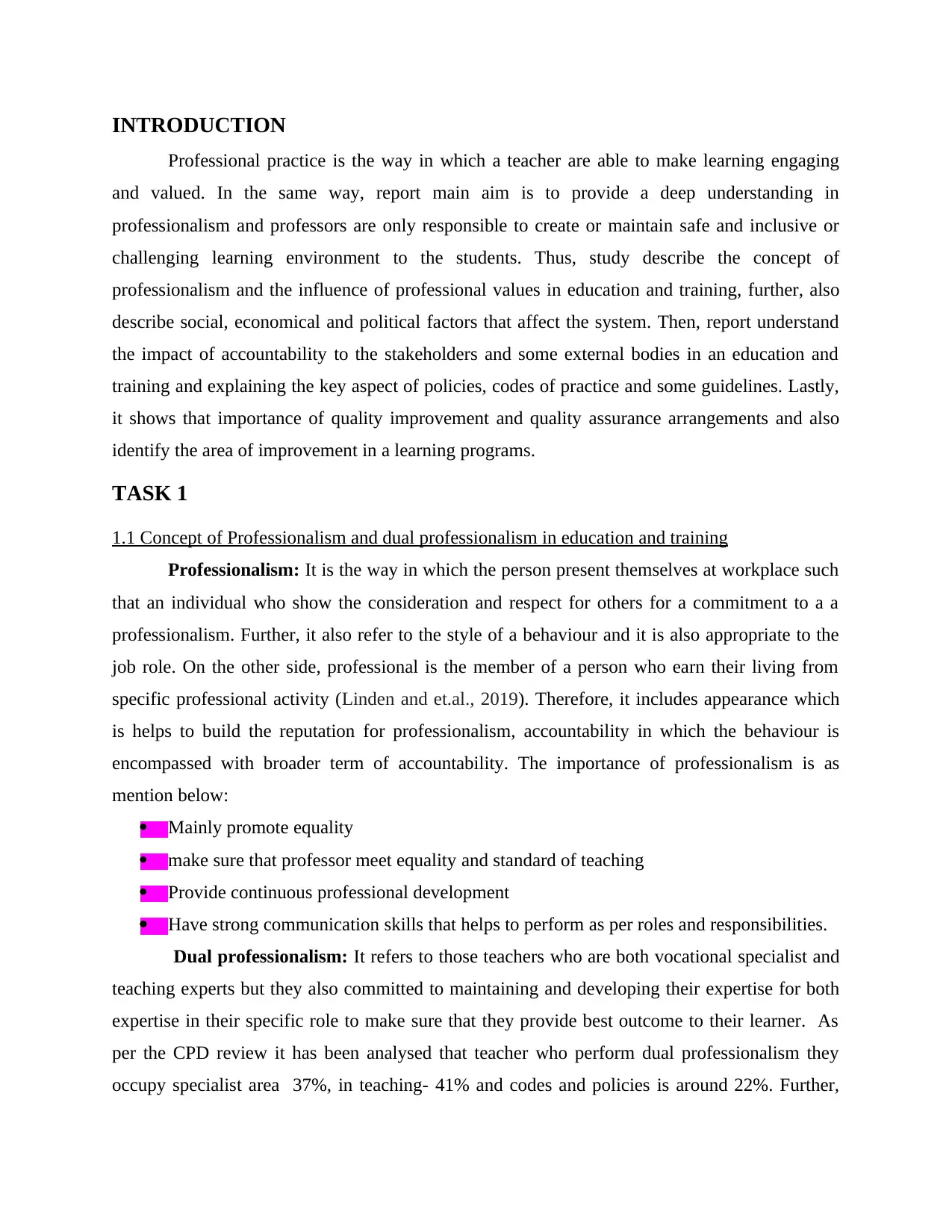
INTRODUCTION
Professional practice is the way in which a teacher are able to make learning engaging
and valued. In the same way, report main aim is to provide a deep understanding in
professionalism and professors are only responsible to create or maintain safe and inclusive or
challenging learning environment to the students. Thus, study describe the concept of
professionalism and the influence of professional values in education and training, further, also
describe social, economical and political factors that affect the system. Then, report understand
the impact of accountability to the stakeholders and some external bodies in an education and
training and explaining the key aspect of policies, codes of practice and some guidelines. Lastly,
it shows that importance of quality improvement and quality assurance arrangements and also
identify the area of improvement in a learning programs.
TASK 1
1.1 Concept of Professionalism and dual professionalism in education and training
Professionalism: It is the way in which the person present themselves at workplace such
that an individual who show the consideration and respect for others for a commitment to a a
professionalism. Further, it also refer to the style of a behaviour and it is also appropriate to the
job role. On the other side, professional is the member of a person who earn their living from
specific professional activity (Linden and et.al., 2019). Therefore, it includes appearance which
is helps to build the reputation for professionalism, accountability in which the behaviour is
encompassed with broader term of accountability. The importance of professionalism is as
mention below:
Mainly promote equality
make sure that professor meet equality and standard of teaching
Provide continuous professional development
Have strong communication skills that helps to perform as per roles and responsibilities.
Dual professionalism: It refers to those teachers who are both vocational specialist and
teaching experts but they also committed to maintaining and developing their expertise for both
expertise in their specific role to make sure that they provide best outcome to their learner. As
per the CPD review it has been analysed that teacher who perform dual professionalism they
occupy specialist area 37%, in teaching- 41% and codes and policies is around 22%. Further,
Professional practice is the way in which a teacher are able to make learning engaging
and valued. In the same way, report main aim is to provide a deep understanding in
professionalism and professors are only responsible to create or maintain safe and inclusive or
challenging learning environment to the students. Thus, study describe the concept of
professionalism and the influence of professional values in education and training, further, also
describe social, economical and political factors that affect the system. Then, report understand
the impact of accountability to the stakeholders and some external bodies in an education and
training and explaining the key aspect of policies, codes of practice and some guidelines. Lastly,
it shows that importance of quality improvement and quality assurance arrangements and also
identify the area of improvement in a learning programs.
TASK 1
1.1 Concept of Professionalism and dual professionalism in education and training
Professionalism: It is the way in which the person present themselves at workplace such
that an individual who show the consideration and respect for others for a commitment to a a
professionalism. Further, it also refer to the style of a behaviour and it is also appropriate to the
job role. On the other side, professional is the member of a person who earn their living from
specific professional activity (Linden and et.al., 2019). Therefore, it includes appearance which
is helps to build the reputation for professionalism, accountability in which the behaviour is
encompassed with broader term of accountability. The importance of professionalism is as
mention below:
Mainly promote equality
make sure that professor meet equality and standard of teaching
Provide continuous professional development
Have strong communication skills that helps to perform as per roles and responsibilities.
Dual professionalism: It refers to those teachers who are both vocational specialist and
teaching experts but they also committed to maintaining and developing their expertise for both
expertise in their specific role to make sure that they provide best outcome to their learner. As
per the CPD review it has been analysed that teacher who perform dual professionalism they
occupy specialist area 37%, in teaching- 41% and codes and policies is around 22%. Further,
⊘ This is a preview!⊘
Do you want full access?
Subscribe today to unlock all pages.

Trusted by 1+ million students worldwide

there are many members of professional bodies such as Institute for Learning, Society for
Education and Training (Samuel, 2019).
1.2 Explaining the ways in which own professional values influence own practice
There are many ways through which professional values are influencing the education
and training, some of them are as mention below:
A professional should promoting the quality in teaching and learning so that the learners
will easily understand the exact message of the teacher.
It is quite necessary for the teacher to meet the organizational policies and procedures so
that they can easily deliver the exact message to their learner and also enhance their own
learning skills as well.
Professors should also keep updating their specialist knowledge and skills and keep
engaging in CPD opportunities in order to improve the professional qualifications.
Because it has been analysed that as per changing world, there is a need to change the
way of teaching so that students will enjoy their learning (Adler and Liyanarachchi,
2019).
By establishing or sharing the best practice in working place, will also help a teacher to
create trust and develop better relationship between students and teachers, so that they
can convey the best message in an innovative way. In this way, the professional values
are delivered and also creates good impact upon the students as well.
TASK 2
2.1 Explaining the ways in which social, political and economic factors that influence education
policy
The education policy is also affected by social, political and economic factors, it has been
analysed that policy is completely dependent on the party in power, which also prevailing the
social view. Thus, these factors are as mention below:
Social Factors: It has been analysed that society's view influence the education policy
and on the other side, government main aim is to prevent the societal agitation. But media has a
significant impact upon views of public, such that if they report any issue in negative way, then it
may cause unease in society (Rowen, 2018). At that time, the public protest and demand
Education and Training (Samuel, 2019).
1.2 Explaining the ways in which own professional values influence own practice
There are many ways through which professional values are influencing the education
and training, some of them are as mention below:
A professional should promoting the quality in teaching and learning so that the learners
will easily understand the exact message of the teacher.
It is quite necessary for the teacher to meet the organizational policies and procedures so
that they can easily deliver the exact message to their learner and also enhance their own
learning skills as well.
Professors should also keep updating their specialist knowledge and skills and keep
engaging in CPD opportunities in order to improve the professional qualifications.
Because it has been analysed that as per changing world, there is a need to change the
way of teaching so that students will enjoy their learning (Adler and Liyanarachchi,
2019).
By establishing or sharing the best practice in working place, will also help a teacher to
create trust and develop better relationship between students and teachers, so that they
can convey the best message in an innovative way. In this way, the professional values
are delivered and also creates good impact upon the students as well.
TASK 2
2.1 Explaining the ways in which social, political and economic factors that influence education
policy
The education policy is also affected by social, political and economic factors, it has been
analysed that policy is completely dependent on the party in power, which also prevailing the
social view. Thus, these factors are as mention below:
Social Factors: It has been analysed that society's view influence the education policy
and on the other side, government main aim is to prevent the societal agitation. But media has a
significant impact upon views of public, such that if they report any issue in negative way, then it
may cause unease in society (Rowen, 2018). At that time, the public protest and demand
Paraphrase This Document
Need a fresh take? Get an instant paraphrase of this document with our AI Paraphraser
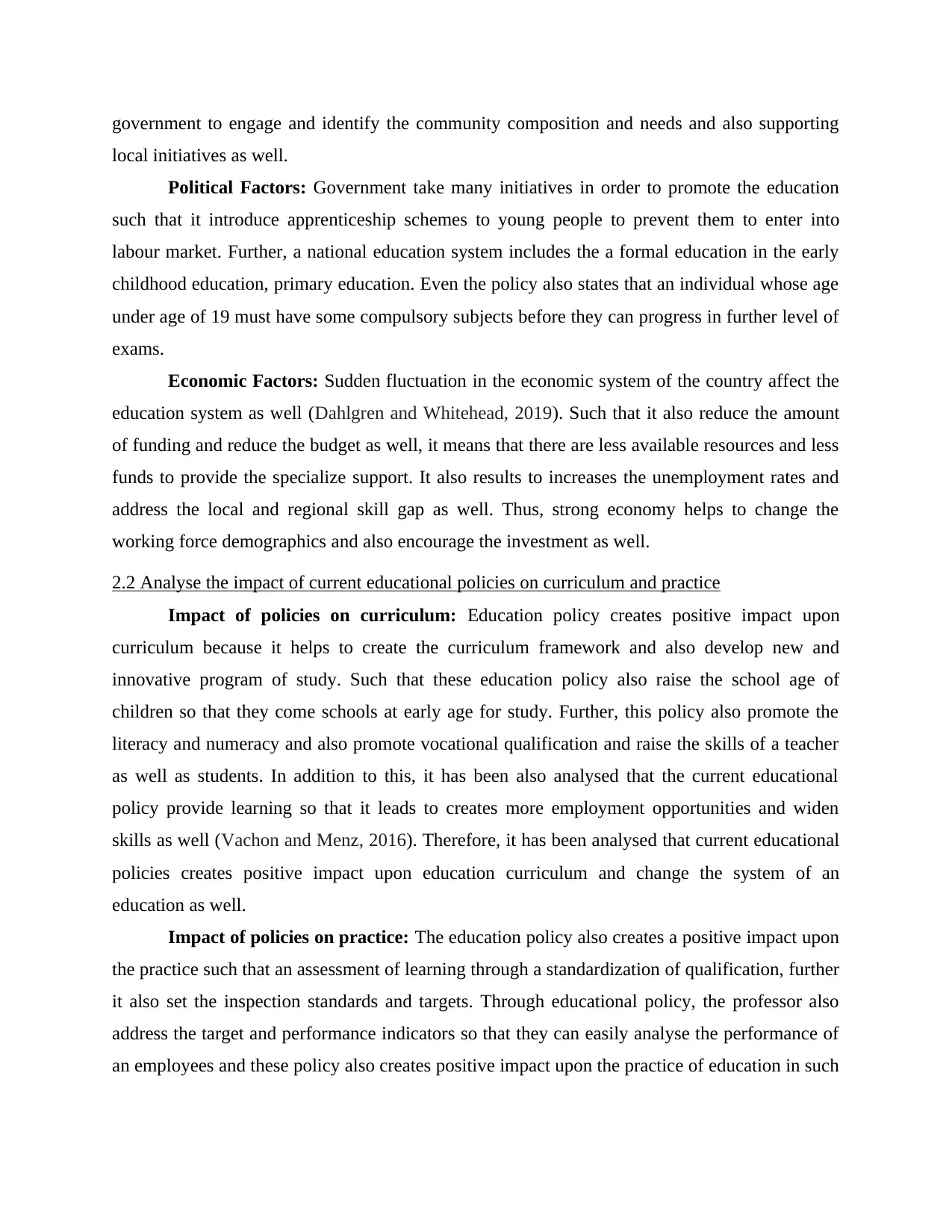
government to engage and identify the community composition and needs and also supporting
local initiatives as well.
Political Factors: Government take many initiatives in order to promote the education
such that it introduce apprenticeship schemes to young people to prevent them to enter into
labour market. Further, a national education system includes the a formal education in the early
childhood education, primary education. Even the policy also states that an individual whose age
under age of 19 must have some compulsory subjects before they can progress in further level of
exams.
Economic Factors: Sudden fluctuation in the economic system of the country affect the
education system as well (Dahlgren and Whitehead, 2019). Such that it also reduce the amount
of funding and reduce the budget as well, it means that there are less available resources and less
funds to provide the specialize support. It also results to increases the unemployment rates and
address the local and regional skill gap as well. Thus, strong economy helps to change the
working force demographics and also encourage the investment as well.
2.2 Analyse the impact of current educational policies on curriculum and practice
Impact of policies on curriculum: Education policy creates positive impact upon
curriculum because it helps to create the curriculum framework and also develop new and
innovative program of study. Such that these education policy also raise the school age of
children so that they come schools at early age for study. Further, this policy also promote the
literacy and numeracy and also promote vocational qualification and raise the skills of a teacher
as well as students. In addition to this, it has been also analysed that the current educational
policy provide learning so that it leads to creates more employment opportunities and widen
skills as well (Vachon and Menz, 2016). Therefore, it has been analysed that current educational
policies creates positive impact upon education curriculum and change the system of an
education as well.
Impact of policies on practice: The education policy also creates a positive impact upon
the practice such that an assessment of learning through a standardization of qualification, further
it also set the inspection standards and targets. Through educational policy, the professor also
address the target and performance indicators so that they can easily analyse the performance of
an employees and these policy also creates positive impact upon the practice of education in such
local initiatives as well.
Political Factors: Government take many initiatives in order to promote the education
such that it introduce apprenticeship schemes to young people to prevent them to enter into
labour market. Further, a national education system includes the a formal education in the early
childhood education, primary education. Even the policy also states that an individual whose age
under age of 19 must have some compulsory subjects before they can progress in further level of
exams.
Economic Factors: Sudden fluctuation in the economic system of the country affect the
education system as well (Dahlgren and Whitehead, 2019). Such that it also reduce the amount
of funding and reduce the budget as well, it means that there are less available resources and less
funds to provide the specialize support. It also results to increases the unemployment rates and
address the local and regional skill gap as well. Thus, strong economy helps to change the
working force demographics and also encourage the investment as well.
2.2 Analyse the impact of current educational policies on curriculum and practice
Impact of policies on curriculum: Education policy creates positive impact upon
curriculum because it helps to create the curriculum framework and also develop new and
innovative program of study. Such that these education policy also raise the school age of
children so that they come schools at early age for study. Further, this policy also promote the
literacy and numeracy and also promote vocational qualification and raise the skills of a teacher
as well as students. In addition to this, it has been also analysed that the current educational
policy provide learning so that it leads to creates more employment opportunities and widen
skills as well (Vachon and Menz, 2016). Therefore, it has been analysed that current educational
policies creates positive impact upon education curriculum and change the system of an
education as well.
Impact of policies on practice: The education policy also creates a positive impact upon
the practice such that an assessment of learning through a standardization of qualification, further
it also set the inspection standards and targets. Through educational policy, the professor also
address the target and performance indicators so that they can easily analyse the performance of
an employees and these policy also creates positive impact upon the practice of education in such
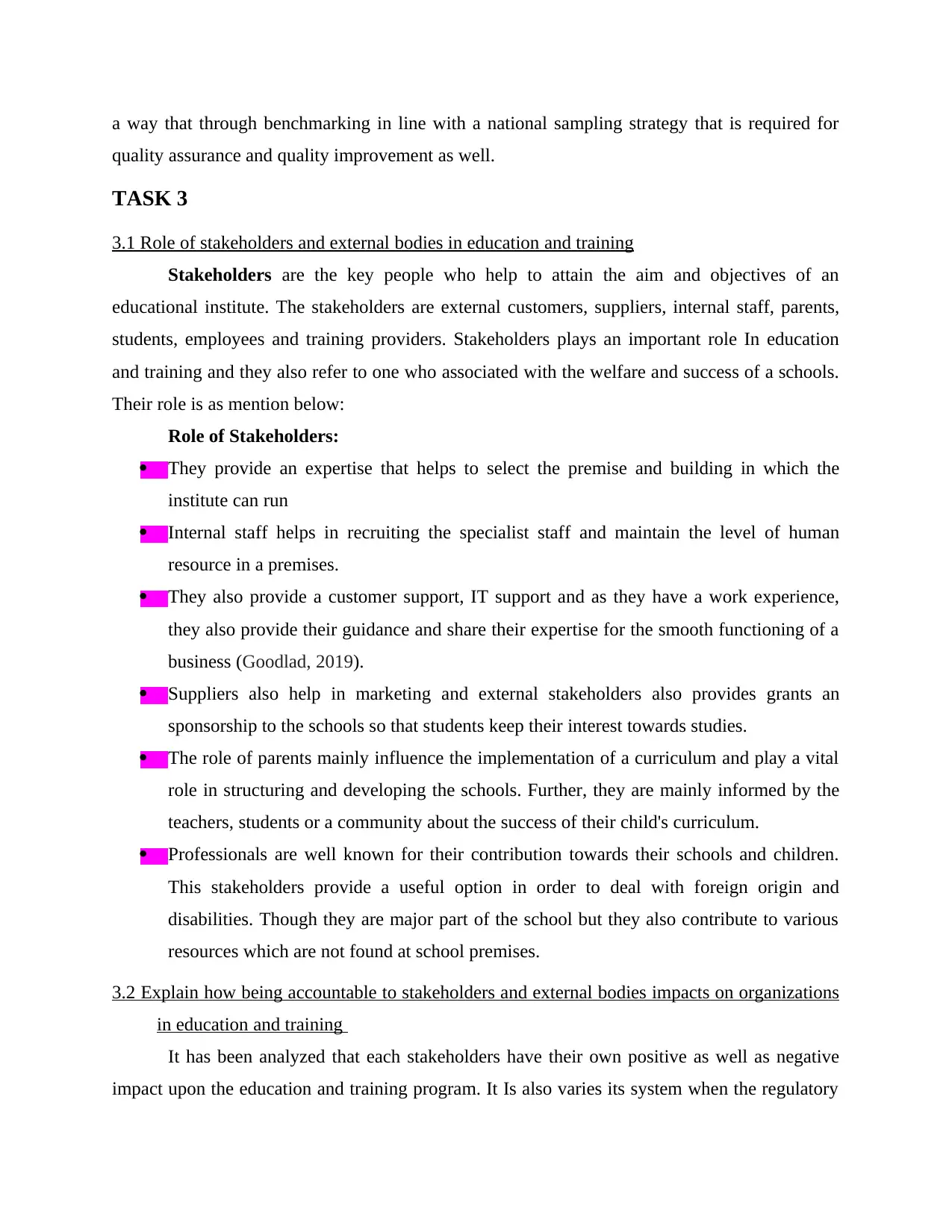
a way that through benchmarking in line with a national sampling strategy that is required for
quality assurance and quality improvement as well.
TASK 3
3.1 Role of stakeholders and external bodies in education and training
Stakeholders are the key people who help to attain the aim and objectives of an
educational institute. The stakeholders are external customers, suppliers, internal staff, parents,
students, employees and training providers. Stakeholders plays an important role In education
and training and they also refer to one who associated with the welfare and success of a schools.
Their role is as mention below:
Role of Stakeholders:
They provide an expertise that helps to select the premise and building in which the
institute can run
Internal staff helps in recruiting the specialist staff and maintain the level of human
resource in a premises.
They also provide a customer support, IT support and as they have a work experience,
they also provide their guidance and share their expertise for the smooth functioning of a
business (Goodlad, 2019).
Suppliers also help in marketing and external stakeholders also provides grants an
sponsorship to the schools so that students keep their interest towards studies.
The role of parents mainly influence the implementation of a curriculum and play a vital
role in structuring and developing the schools. Further, they are mainly informed by the
teachers, students or a community about the success of their child's curriculum.
Professionals are well known for their contribution towards their schools and children.
This stakeholders provide a useful option in order to deal with foreign origin and
disabilities. Though they are major part of the school but they also contribute to various
resources which are not found at school premises.
3.2 Explain how being accountable to stakeholders and external bodies impacts on organizations
in education and training
It has been analyzed that each stakeholders have their own positive as well as negative
impact upon the education and training program. It Is also varies its system when the regulatory
quality assurance and quality improvement as well.
TASK 3
3.1 Role of stakeholders and external bodies in education and training
Stakeholders are the key people who help to attain the aim and objectives of an
educational institute. The stakeholders are external customers, suppliers, internal staff, parents,
students, employees and training providers. Stakeholders plays an important role In education
and training and they also refer to one who associated with the welfare and success of a schools.
Their role is as mention below:
Role of Stakeholders:
They provide an expertise that helps to select the premise and building in which the
institute can run
Internal staff helps in recruiting the specialist staff and maintain the level of human
resource in a premises.
They also provide a customer support, IT support and as they have a work experience,
they also provide their guidance and share their expertise for the smooth functioning of a
business (Goodlad, 2019).
Suppliers also help in marketing and external stakeholders also provides grants an
sponsorship to the schools so that students keep their interest towards studies.
The role of parents mainly influence the implementation of a curriculum and play a vital
role in structuring and developing the schools. Further, they are mainly informed by the
teachers, students or a community about the success of their child's curriculum.
Professionals are well known for their contribution towards their schools and children.
This stakeholders provide a useful option in order to deal with foreign origin and
disabilities. Though they are major part of the school but they also contribute to various
resources which are not found at school premises.
3.2 Explain how being accountable to stakeholders and external bodies impacts on organizations
in education and training
It has been analyzed that each stakeholders have their own positive as well as negative
impact upon the education and training program. It Is also varies its system when the regulatory
⊘ This is a preview!⊘
Do you want full access?
Subscribe today to unlock all pages.

Trusted by 1+ million students worldwide
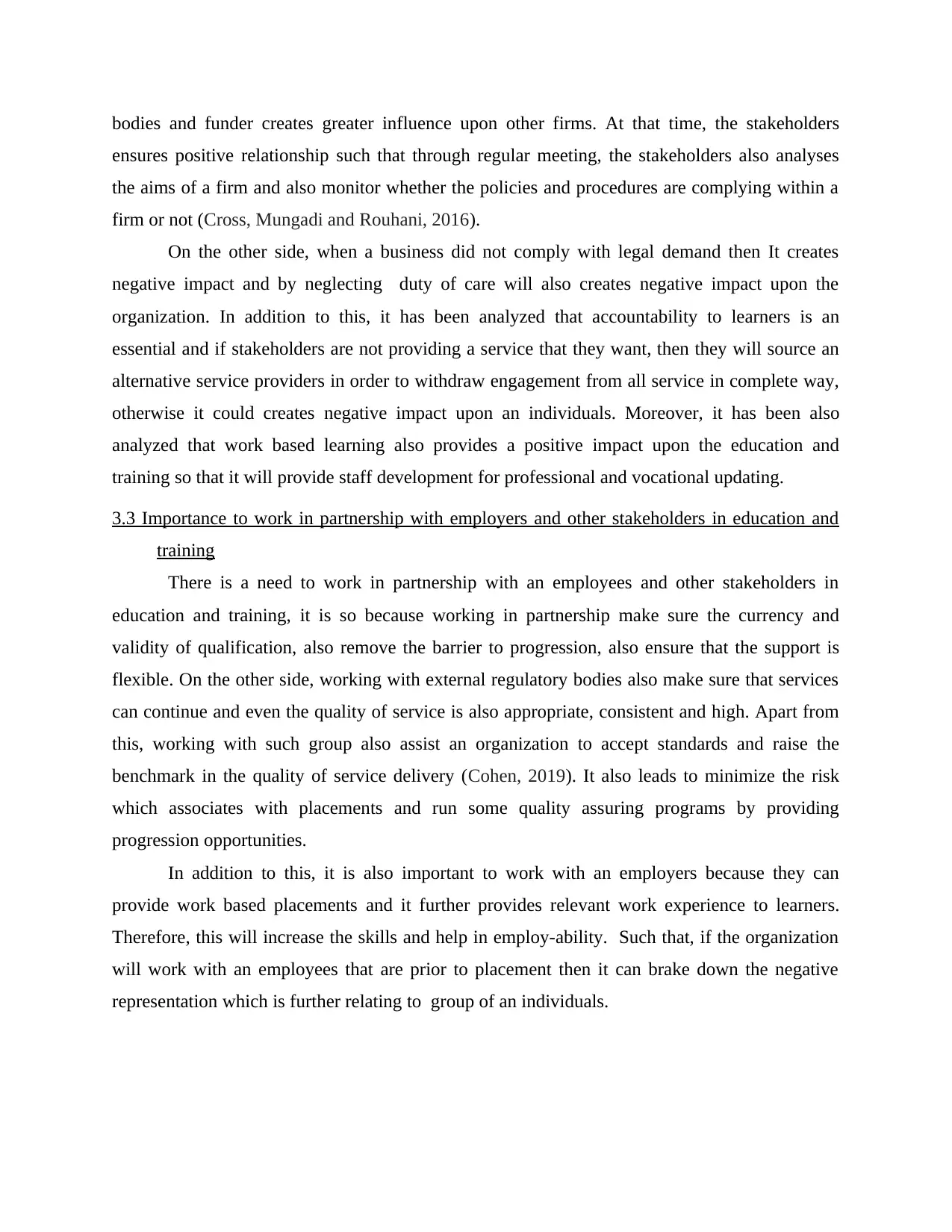
bodies and funder creates greater influence upon other firms. At that time, the stakeholders
ensures positive relationship such that through regular meeting, the stakeholders also analyses
the aims of a firm and also monitor whether the policies and procedures are complying within a
firm or not (Cross, Mungadi and Rouhani, 2016).
On the other side, when a business did not comply with legal demand then It creates
negative impact and by neglecting duty of care will also creates negative impact upon the
organization. In addition to this, it has been analyzed that accountability to learners is an
essential and if stakeholders are not providing a service that they want, then they will source an
alternative service providers in order to withdraw engagement from all service in complete way,
otherwise it could creates negative impact upon an individuals. Moreover, it has been also
analyzed that work based learning also provides a positive impact upon the education and
training so that it will provide staff development for professional and vocational updating.
3.3 Importance to work in partnership with employers and other stakeholders in education and
training
There is a need to work in partnership with an employees and other stakeholders in
education and training, it is so because working in partnership make sure the currency and
validity of qualification, also remove the barrier to progression, also ensure that the support is
flexible. On the other side, working with external regulatory bodies also make sure that services
can continue and even the quality of service is also appropriate, consistent and high. Apart from
this, working with such group also assist an organization to accept standards and raise the
benchmark in the quality of service delivery (Cohen, 2019). It also leads to minimize the risk
which associates with placements and run some quality assuring programs by providing
progression opportunities.
In addition to this, it is also important to work with an employers because they can
provide work based placements and it further provides relevant work experience to learners.
Therefore, this will increase the skills and help in employ-ability. Such that, if the organization
will work with an employees that are prior to placement then it can brake down the negative
representation which is further relating to group of an individuals.
ensures positive relationship such that through regular meeting, the stakeholders also analyses
the aims of a firm and also monitor whether the policies and procedures are complying within a
firm or not (Cross, Mungadi and Rouhani, 2016).
On the other side, when a business did not comply with legal demand then It creates
negative impact and by neglecting duty of care will also creates negative impact upon the
organization. In addition to this, it has been analyzed that accountability to learners is an
essential and if stakeholders are not providing a service that they want, then they will source an
alternative service providers in order to withdraw engagement from all service in complete way,
otherwise it could creates negative impact upon an individuals. Moreover, it has been also
analyzed that work based learning also provides a positive impact upon the education and
training so that it will provide staff development for professional and vocational updating.
3.3 Importance to work in partnership with employers and other stakeholders in education and
training
There is a need to work in partnership with an employees and other stakeholders in
education and training, it is so because working in partnership make sure the currency and
validity of qualification, also remove the barrier to progression, also ensure that the support is
flexible. On the other side, working with external regulatory bodies also make sure that services
can continue and even the quality of service is also appropriate, consistent and high. Apart from
this, working with such group also assist an organization to accept standards and raise the
benchmark in the quality of service delivery (Cohen, 2019). It also leads to minimize the risk
which associates with placements and run some quality assuring programs by providing
progression opportunities.
In addition to this, it is also important to work with an employers because they can
provide work based placements and it further provides relevant work experience to learners.
Therefore, this will increase the skills and help in employ-ability. Such that, if the organization
will work with an employees that are prior to placement then it can brake down the negative
representation which is further relating to group of an individuals.
Paraphrase This Document
Need a fresh take? Get an instant paraphrase of this document with our AI Paraphraser
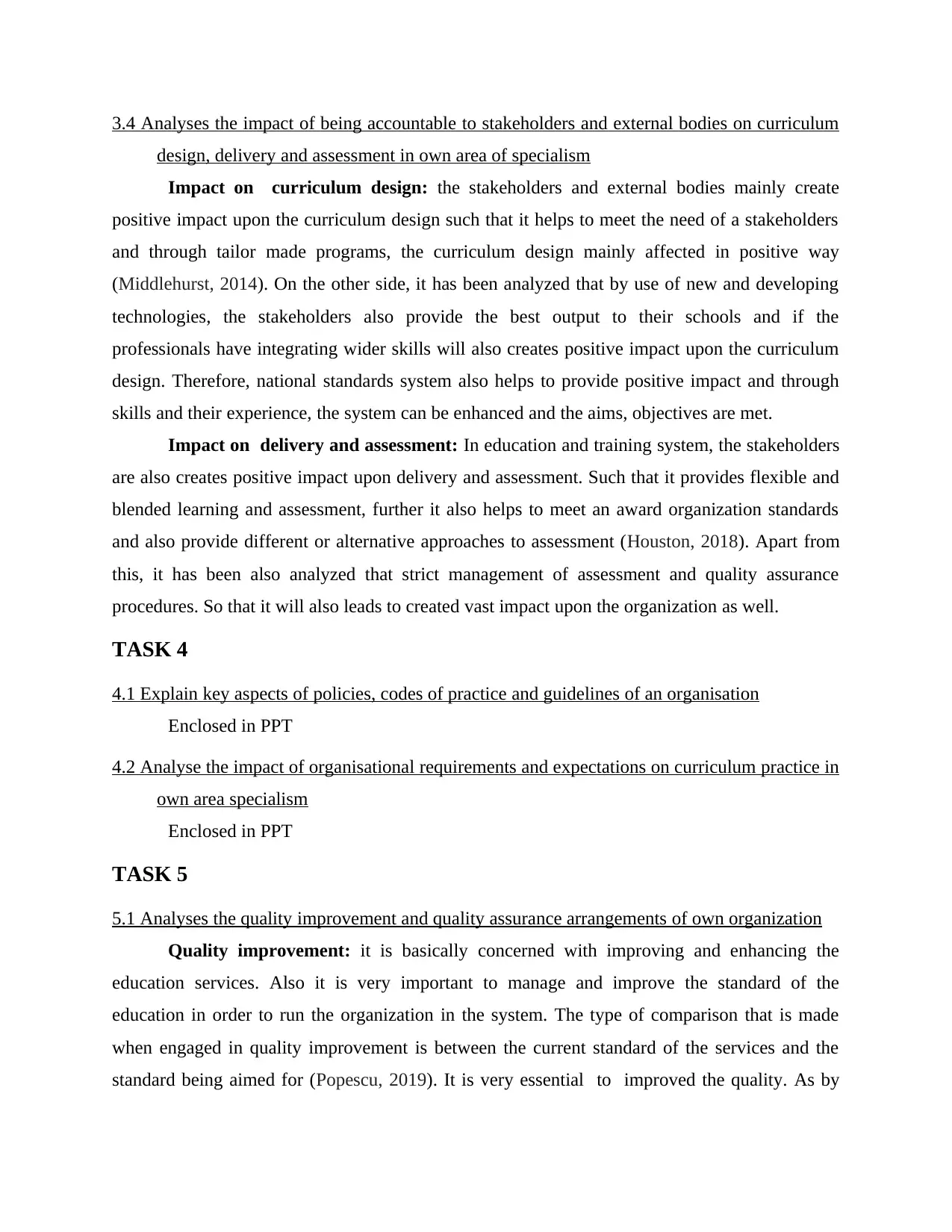
3.4 Analyses the impact of being accountable to stakeholders and external bodies on curriculum
design, delivery and assessment in own area of specialism
Impact on curriculum design: the stakeholders and external bodies mainly create
positive impact upon the curriculum design such that it helps to meet the need of a stakeholders
and through tailor made programs, the curriculum design mainly affected in positive way
(Middlehurst, 2014). On the other side, it has been analyzed that by use of new and developing
technologies, the stakeholders also provide the best output to their schools and if the
professionals have integrating wider skills will also creates positive impact upon the curriculum
design. Therefore, national standards system also helps to provide positive impact and through
skills and their experience, the system can be enhanced and the aims, objectives are met.
Impact on delivery and assessment: In education and training system, the stakeholders
are also creates positive impact upon delivery and assessment. Such that it provides flexible and
blended learning and assessment, further it also helps to meet an award organization standards
and also provide different or alternative approaches to assessment (Houston, 2018). Apart from
this, it has been also analyzed that strict management of assessment and quality assurance
procedures. So that it will also leads to created vast impact upon the organization as well.
TASK 4
4.1 Explain key aspects of policies, codes of practice and guidelines of an organisation
Enclosed in PPT
4.2 Analyse the impact of organisational requirements and expectations on curriculum practice in
own area specialism
Enclosed in PPT
TASK 5
5.1 Analyses the quality improvement and quality assurance arrangements of own organization
Quality improvement: it is basically concerned with improving and enhancing the
education services. Also it is very important to manage and improve the standard of the
education in order to run the organization in the system. The type of comparison that is made
when engaged in quality improvement is between the current standard of the services and the
standard being aimed for (Popescu, 2019). It is very essential to improved the quality. As by
design, delivery and assessment in own area of specialism
Impact on curriculum design: the stakeholders and external bodies mainly create
positive impact upon the curriculum design such that it helps to meet the need of a stakeholders
and through tailor made programs, the curriculum design mainly affected in positive way
(Middlehurst, 2014). On the other side, it has been analyzed that by use of new and developing
technologies, the stakeholders also provide the best output to their schools and if the
professionals have integrating wider skills will also creates positive impact upon the curriculum
design. Therefore, national standards system also helps to provide positive impact and through
skills and their experience, the system can be enhanced and the aims, objectives are met.
Impact on delivery and assessment: In education and training system, the stakeholders
are also creates positive impact upon delivery and assessment. Such that it provides flexible and
blended learning and assessment, further it also helps to meet an award organization standards
and also provide different or alternative approaches to assessment (Houston, 2018). Apart from
this, it has been also analyzed that strict management of assessment and quality assurance
procedures. So that it will also leads to created vast impact upon the organization as well.
TASK 4
4.1 Explain key aspects of policies, codes of practice and guidelines of an organisation
Enclosed in PPT
4.2 Analyse the impact of organisational requirements and expectations on curriculum practice in
own area specialism
Enclosed in PPT
TASK 5
5.1 Analyses the quality improvement and quality assurance arrangements of own organization
Quality improvement: it is basically concerned with improving and enhancing the
education services. Also it is very important to manage and improve the standard of the
education in order to run the organization in the system. The type of comparison that is made
when engaged in quality improvement is between the current standard of the services and the
standard being aimed for (Popescu, 2019). It is very essential to improved the quality. As by
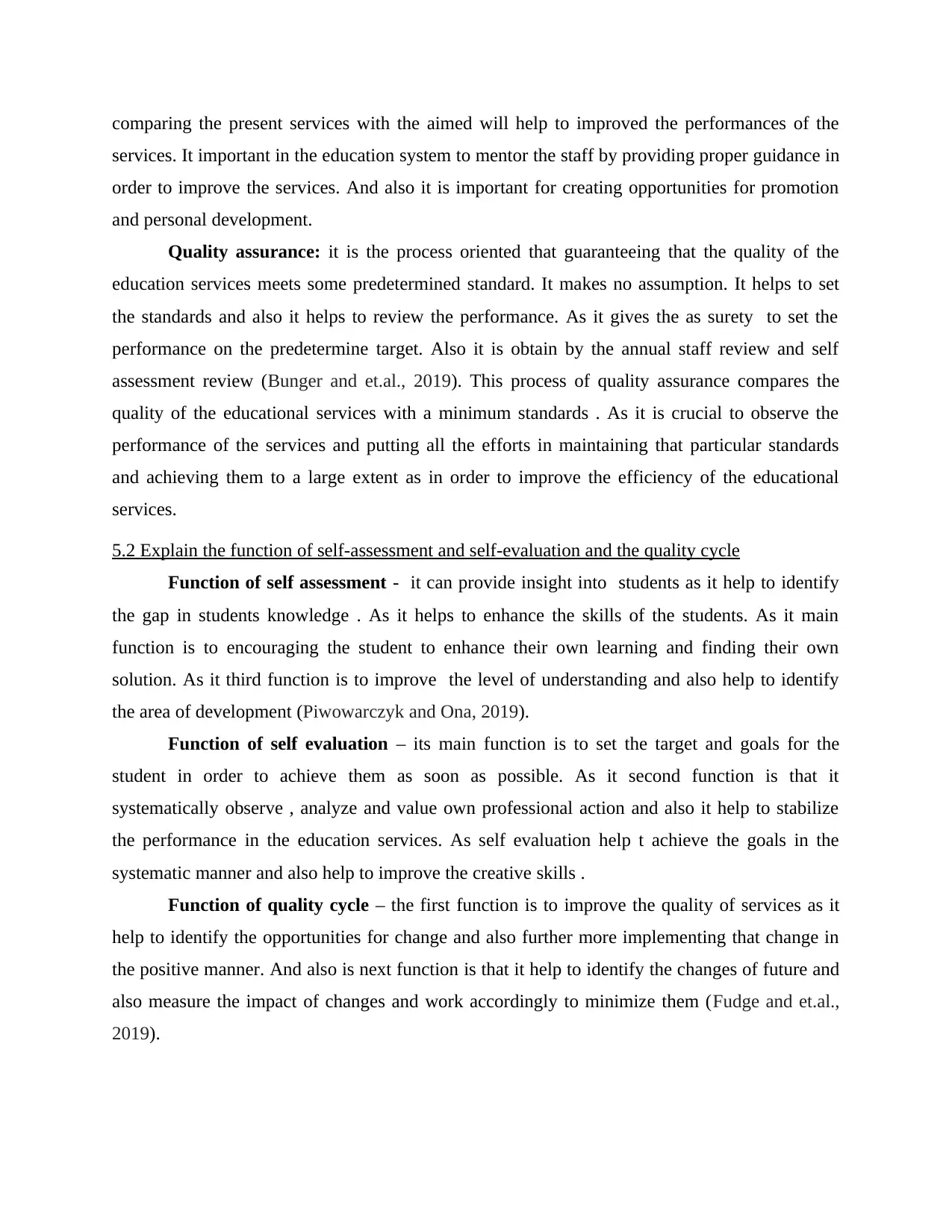
comparing the present services with the aimed will help to improved the performances of the
services. It important in the education system to mentor the staff by providing proper guidance in
order to improve the services. And also it is important for creating opportunities for promotion
and personal development.
Quality assurance: it is the process oriented that guaranteeing that the quality of the
education services meets some predetermined standard. It makes no assumption. It helps to set
the standards and also it helps to review the performance. As it gives the as surety to set the
performance on the predetermine target. Also it is obtain by the annual staff review and self
assessment review (Bunger and et.al., 2019). This process of quality assurance compares the
quality of the educational services with a minimum standards . As it is crucial to observe the
performance of the services and putting all the efforts in maintaining that particular standards
and achieving them to a large extent as in order to improve the efficiency of the educational
services.
5.2 Explain the function of self-assessment and self-evaluation and the quality cycle
Function of self assessment - it can provide insight into students as it help to identify
the gap in students knowledge . As it helps to enhance the skills of the students. As it main
function is to encouraging the student to enhance their own learning and finding their own
solution. As it third function is to improve the level of understanding and also help to identify
the area of development (Piwowarczyk and Ona, 2019).
Function of self evaluation – its main function is to set the target and goals for the
student in order to achieve them as soon as possible. As it second function is that it
systematically observe , analyze and value own professional action and also it help to stabilize
the performance in the education services. As self evaluation help t achieve the goals in the
systematic manner and also help to improve the creative skills .
Function of quality cycle – the first function is to improve the quality of services as it
help to identify the opportunities for change and also further more implementing that change in
the positive manner. And also is next function is that it help to identify the changes of future and
also measure the impact of changes and work accordingly to minimize them (Fudge and et.al.,
2019).
services. It important in the education system to mentor the staff by providing proper guidance in
order to improve the services. And also it is important for creating opportunities for promotion
and personal development.
Quality assurance: it is the process oriented that guaranteeing that the quality of the
education services meets some predetermined standard. It makes no assumption. It helps to set
the standards and also it helps to review the performance. As it gives the as surety to set the
performance on the predetermine target. Also it is obtain by the annual staff review and self
assessment review (Bunger and et.al., 2019). This process of quality assurance compares the
quality of the educational services with a minimum standards . As it is crucial to observe the
performance of the services and putting all the efforts in maintaining that particular standards
and achieving them to a large extent as in order to improve the efficiency of the educational
services.
5.2 Explain the function of self-assessment and self-evaluation and the quality cycle
Function of self assessment - it can provide insight into students as it help to identify
the gap in students knowledge . As it helps to enhance the skills of the students. As it main
function is to encouraging the student to enhance their own learning and finding their own
solution. As it third function is to improve the level of understanding and also help to identify
the area of development (Piwowarczyk and Ona, 2019).
Function of self evaluation – its main function is to set the target and goals for the
student in order to achieve them as soon as possible. As it second function is that it
systematically observe , analyze and value own professional action and also it help to stabilize
the performance in the education services. As self evaluation help t achieve the goals in the
systematic manner and also help to improve the creative skills .
Function of quality cycle – the first function is to improve the quality of services as it
help to identify the opportunities for change and also further more implementing that change in
the positive manner. And also is next function is that it help to identify the changes of future and
also measure the impact of changes and work accordingly to minimize them (Fudge and et.al.,
2019).
⊘ This is a preview!⊘
Do you want full access?
Subscribe today to unlock all pages.

Trusted by 1+ million students worldwide
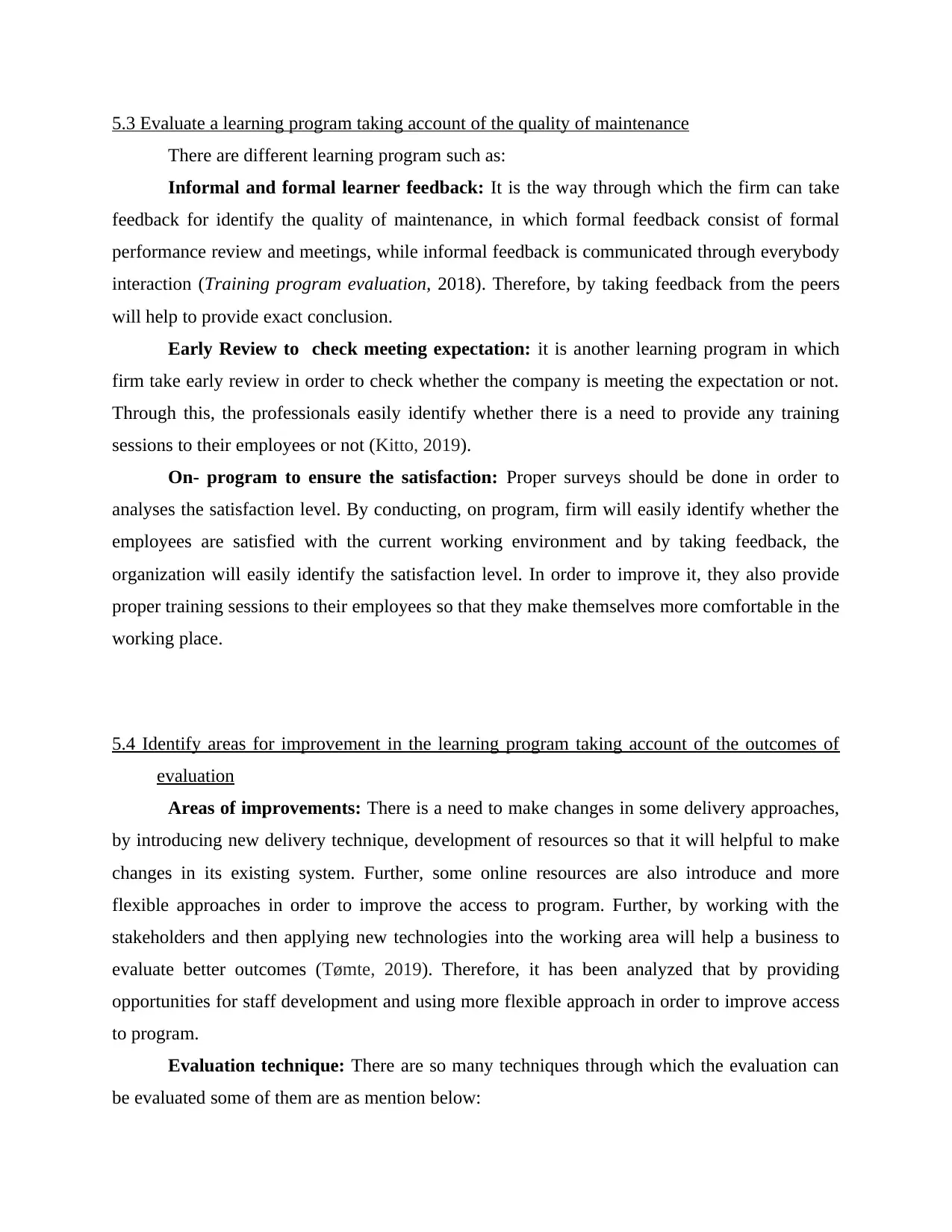
5.3 Evaluate a learning program taking account of the quality of maintenance
There are different learning program such as:
Informal and formal learner feedback: It is the way through which the firm can take
feedback for identify the quality of maintenance, in which formal feedback consist of formal
performance review and meetings, while informal feedback is communicated through everybody
interaction (Training program evaluation, 2018). Therefore, by taking feedback from the peers
will help to provide exact conclusion.
Early Review to check meeting expectation: it is another learning program in which
firm take early review in order to check whether the company is meeting the expectation or not.
Through this, the professionals easily identify whether there is a need to provide any training
sessions to their employees or not (Kitto, 2019).
On- program to ensure the satisfaction: Proper surveys should be done in order to
analyses the satisfaction level. By conducting, on program, firm will easily identify whether the
employees are satisfied with the current working environment and by taking feedback, the
organization will easily identify the satisfaction level. In order to improve it, they also provide
proper training sessions to their employees so that they make themselves more comfortable in the
working place.
5.4 Identify areas for improvement in the learning program taking account of the outcomes of
evaluation
Areas of improvements: There is a need to make changes in some delivery approaches,
by introducing new delivery technique, development of resources so that it will helpful to make
changes in its existing system. Further, some online resources are also introduce and more
flexible approaches in order to improve the access to program. Further, by working with the
stakeholders and then applying new technologies into the working area will help a business to
evaluate better outcomes (Tømte, 2019). Therefore, it has been analyzed that by providing
opportunities for staff development and using more flexible approach in order to improve access
to program.
Evaluation technique: There are so many techniques through which the evaluation can
be evaluated some of them are as mention below:
There are different learning program such as:
Informal and formal learner feedback: It is the way through which the firm can take
feedback for identify the quality of maintenance, in which formal feedback consist of formal
performance review and meetings, while informal feedback is communicated through everybody
interaction (Training program evaluation, 2018). Therefore, by taking feedback from the peers
will help to provide exact conclusion.
Early Review to check meeting expectation: it is another learning program in which
firm take early review in order to check whether the company is meeting the expectation or not.
Through this, the professionals easily identify whether there is a need to provide any training
sessions to their employees or not (Kitto, 2019).
On- program to ensure the satisfaction: Proper surveys should be done in order to
analyses the satisfaction level. By conducting, on program, firm will easily identify whether the
employees are satisfied with the current working environment and by taking feedback, the
organization will easily identify the satisfaction level. In order to improve it, they also provide
proper training sessions to their employees so that they make themselves more comfortable in the
working place.
5.4 Identify areas for improvement in the learning program taking account of the outcomes of
evaluation
Areas of improvements: There is a need to make changes in some delivery approaches,
by introducing new delivery technique, development of resources so that it will helpful to make
changes in its existing system. Further, some online resources are also introduce and more
flexible approaches in order to improve the access to program. Further, by working with the
stakeholders and then applying new technologies into the working area will help a business to
evaluate better outcomes (Tømte, 2019). Therefore, it has been analyzed that by providing
opportunities for staff development and using more flexible approach in order to improve access
to program.
Evaluation technique: There are so many techniques through which the evaluation can
be evaluated some of them are as mention below:
Paraphrase This Document
Need a fresh take? Get an instant paraphrase of this document with our AI Paraphraser
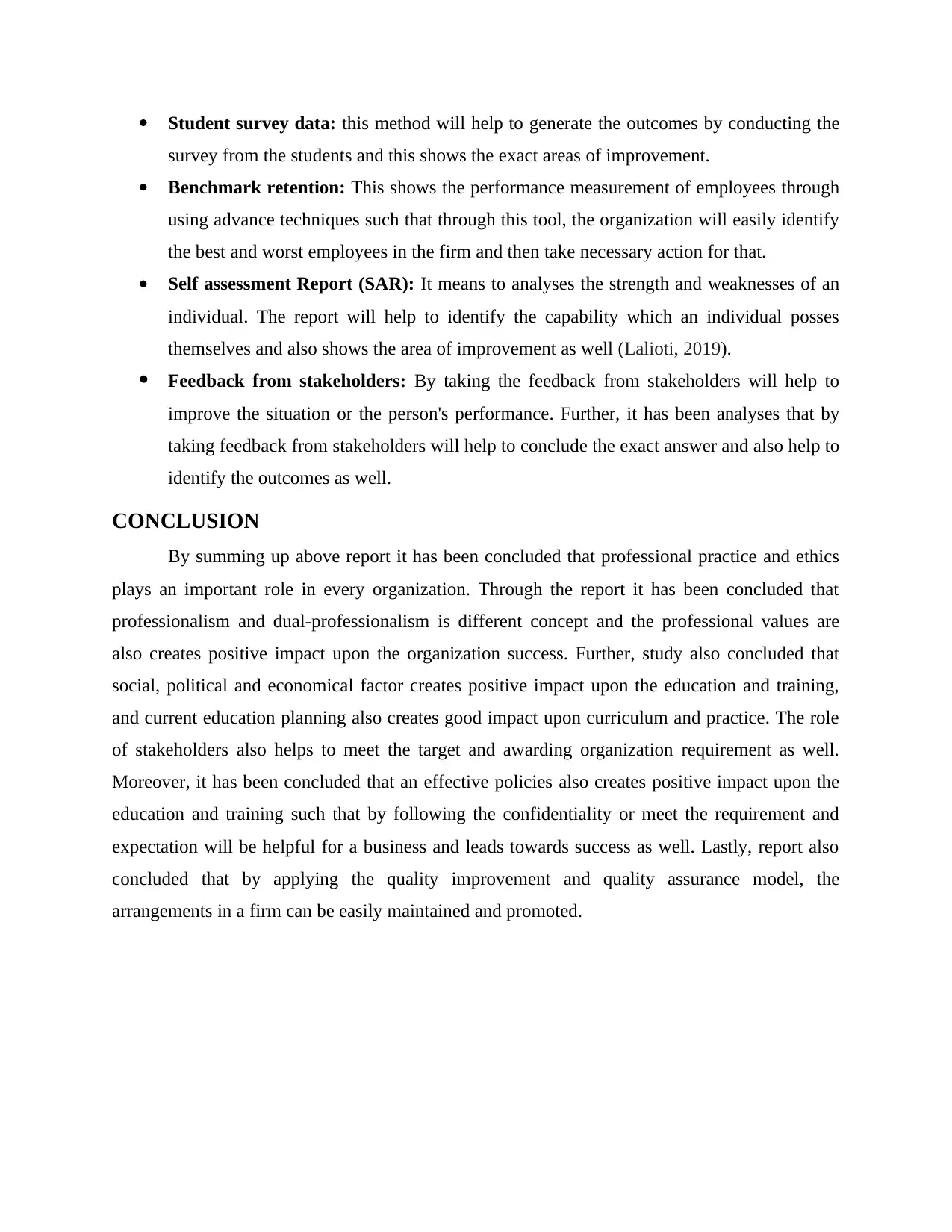
Student survey data: this method will help to generate the outcomes by conducting the
survey from the students and this shows the exact areas of improvement.
Benchmark retention: This shows the performance measurement of employees through
using advance techniques such that through this tool, the organization will easily identify
the best and worst employees in the firm and then take necessary action for that.
Self assessment Report (SAR): It means to analyses the strength and weaknesses of an
individual. The report will help to identify the capability which an individual posses
themselves and also shows the area of improvement as well (Lalioti, 2019).
Feedback from stakeholders: By taking the feedback from stakeholders will help to
improve the situation or the person's performance. Further, it has been analyses that by
taking feedback from stakeholders will help to conclude the exact answer and also help to
identify the outcomes as well.
CONCLUSION
By summing up above report it has been concluded that professional practice and ethics
plays an important role in every organization. Through the report it has been concluded that
professionalism and dual-professionalism is different concept and the professional values are
also creates positive impact upon the organization success. Further, study also concluded that
social, political and economical factor creates positive impact upon the education and training,
and current education planning also creates good impact upon curriculum and practice. The role
of stakeholders also helps to meet the target and awarding organization requirement as well.
Moreover, it has been concluded that an effective policies also creates positive impact upon the
education and training such that by following the confidentiality or meet the requirement and
expectation will be helpful for a business and leads towards success as well. Lastly, report also
concluded that by applying the quality improvement and quality assurance model, the
arrangements in a firm can be easily maintained and promoted.
survey from the students and this shows the exact areas of improvement.
Benchmark retention: This shows the performance measurement of employees through
using advance techniques such that through this tool, the organization will easily identify
the best and worst employees in the firm and then take necessary action for that.
Self assessment Report (SAR): It means to analyses the strength and weaknesses of an
individual. The report will help to identify the capability which an individual posses
themselves and also shows the area of improvement as well (Lalioti, 2019).
Feedback from stakeholders: By taking the feedback from stakeholders will help to
improve the situation or the person's performance. Further, it has been analyses that by
taking feedback from stakeholders will help to conclude the exact answer and also help to
identify the outcomes as well.
CONCLUSION
By summing up above report it has been concluded that professional practice and ethics
plays an important role in every organization. Through the report it has been concluded that
professionalism and dual-professionalism is different concept and the professional values are
also creates positive impact upon the organization success. Further, study also concluded that
social, political and economical factor creates positive impact upon the education and training,
and current education planning also creates good impact upon curriculum and practice. The role
of stakeholders also helps to meet the target and awarding organization requirement as well.
Moreover, it has been concluded that an effective policies also creates positive impact upon the
education and training such that by following the confidentiality or meet the requirement and
expectation will be helpful for a business and leads towards success as well. Lastly, report also
concluded that by applying the quality improvement and quality assurance model, the
arrangements in a firm can be easily maintained and promoted.

References
Books and Journals
Adler, R. and Liyanarachchi, G., 2019. Towards measuring professionalism in
accounting. Accounting & Finance.
Anderson, E. S., Ford, J. and Thorpe, L., 2019. Perspectives on patients and carers in leading
teaching roles in interprofessional education. Journal of interprofessional care.33(2).
pp.216-225.
Bunger, A. C. and et.al.,2019. The Cost of Quality: Organizational Financial Health and Program
Quality. Journal of Evidence-Based Social Work.16(1). pp.18-35.
Cohen, D. K., 2019. Teaching for understanding: Challenges for policy and practice. Jossey-
Bass Inc., 350 Sansome Street, San Francisco, CA 94104.
Cross, M., Mungadi, R. and Rouhani, S., 2016. From policy to practice: Curriculum reform in
South African education. Comparative education.38(2). pp.171-187.
Dahlgren, G. and Whitehead, M., 2019. Policies and strategies to promote social equity in
health. Stockholm: Institute for future studies.
Fudge, H. and et.al., 2019. 1372: IMPROVING PATIENT FLOW FROM PICU TO
INPATIENT WARDS: A QUALITY ASSURANCE PROCESS. Critical Care
Medicine, 47(1), p.662.
Goodlad, J. I., 2019. Curriculum Inquiry. The Study of Curriculum Practice.
Houston, D., 2018. Rethinking quality and improvement in higher education. Quality Assurance
in Education.16(1). pp.61-79.
Kitto, S., 2019. Quality Assurance in JCEHP. Journal of Continuing Education in the Health
Professions.39(1).
Lalioti, V., 2019. Training‐related dimensions of apprenticeship programmes in crisis‐ridden
Greece: an exploratory study. International Journal of Training and Development, 23(1),
pp.51-68.
Linden, J.A. and et.al., 2019. Variability in Institutional Board Review for a Multisite
Assessment of Resident Professionalism. Journal of Empirical Research on Human
Research Ethics.14(2). pp.117-125.
Middlehurst, R., 2014. Changing internal governance: A discussion of leadership roles and
management structures in UK universities. Higher Education Quarterly. 58(4). pp.258-
279.
Piwowarczyk, L. A. and Ona, F., 2019. BeWell; quality assurance health promotion
pilot. International Journal of Health Care Quality Assurance, (just-accepted), pp.00-00.
Popescu, E., 2019. Quality Assurance and Enhancement in Romanian Research
Libraries. Qualitative and Quantitative Methods in Libraries.6(4). pp.657-670.
Rowen, H. S. ed., 2018. Behind East Asian growth: The political and social foundations of
prosperity. Psychology Press.
Samuel, F., 2019. Professionalism: past, present and future.
Tømte, C. E., 2019. MOOCs in teacher education: institutional and pedagogical
change?. European Journal of Teacher Education.42(1). pp.65-81.
Vachon, S. and Menz, F. C., 2016. The role of social, political, and economic interests in
promoting state green electricity policies. Environmental Science & Policy.9(7-8).
pp.652-662.
Books and Journals
Adler, R. and Liyanarachchi, G., 2019. Towards measuring professionalism in
accounting. Accounting & Finance.
Anderson, E. S., Ford, J. and Thorpe, L., 2019. Perspectives on patients and carers in leading
teaching roles in interprofessional education. Journal of interprofessional care.33(2).
pp.216-225.
Bunger, A. C. and et.al.,2019. The Cost of Quality: Organizational Financial Health and Program
Quality. Journal of Evidence-Based Social Work.16(1). pp.18-35.
Cohen, D. K., 2019. Teaching for understanding: Challenges for policy and practice. Jossey-
Bass Inc., 350 Sansome Street, San Francisco, CA 94104.
Cross, M., Mungadi, R. and Rouhani, S., 2016. From policy to practice: Curriculum reform in
South African education. Comparative education.38(2). pp.171-187.
Dahlgren, G. and Whitehead, M., 2019. Policies and strategies to promote social equity in
health. Stockholm: Institute for future studies.
Fudge, H. and et.al., 2019. 1372: IMPROVING PATIENT FLOW FROM PICU TO
INPATIENT WARDS: A QUALITY ASSURANCE PROCESS. Critical Care
Medicine, 47(1), p.662.
Goodlad, J. I., 2019. Curriculum Inquiry. The Study of Curriculum Practice.
Houston, D., 2018. Rethinking quality and improvement in higher education. Quality Assurance
in Education.16(1). pp.61-79.
Kitto, S., 2019. Quality Assurance in JCEHP. Journal of Continuing Education in the Health
Professions.39(1).
Lalioti, V., 2019. Training‐related dimensions of apprenticeship programmes in crisis‐ridden
Greece: an exploratory study. International Journal of Training and Development, 23(1),
pp.51-68.
Linden, J.A. and et.al., 2019. Variability in Institutional Board Review for a Multisite
Assessment of Resident Professionalism. Journal of Empirical Research on Human
Research Ethics.14(2). pp.117-125.
Middlehurst, R., 2014. Changing internal governance: A discussion of leadership roles and
management structures in UK universities. Higher Education Quarterly. 58(4). pp.258-
279.
Piwowarczyk, L. A. and Ona, F., 2019. BeWell; quality assurance health promotion
pilot. International Journal of Health Care Quality Assurance, (just-accepted), pp.00-00.
Popescu, E., 2019. Quality Assurance and Enhancement in Romanian Research
Libraries. Qualitative and Quantitative Methods in Libraries.6(4). pp.657-670.
Rowen, H. S. ed., 2018. Behind East Asian growth: The political and social foundations of
prosperity. Psychology Press.
Samuel, F., 2019. Professionalism: past, present and future.
Tømte, C. E., 2019. MOOCs in teacher education: institutional and pedagogical
change?. European Journal of Teacher Education.42(1). pp.65-81.
Vachon, S. and Menz, F. C., 2016. The role of social, political, and economic interests in
promoting state green electricity policies. Environmental Science & Policy.9(7-8).
pp.652-662.
⊘ This is a preview!⊘
Do you want full access?
Subscribe today to unlock all pages.

Trusted by 1+ million students worldwide
1 out of 13
Related Documents
Your All-in-One AI-Powered Toolkit for Academic Success.
+13062052269
info@desklib.com
Available 24*7 on WhatsApp / Email
![[object Object]](/_next/static/media/star-bottom.7253800d.svg)
Unlock your academic potential
Copyright © 2020–2025 A2Z Services. All Rights Reserved. Developed and managed by ZUCOL.


